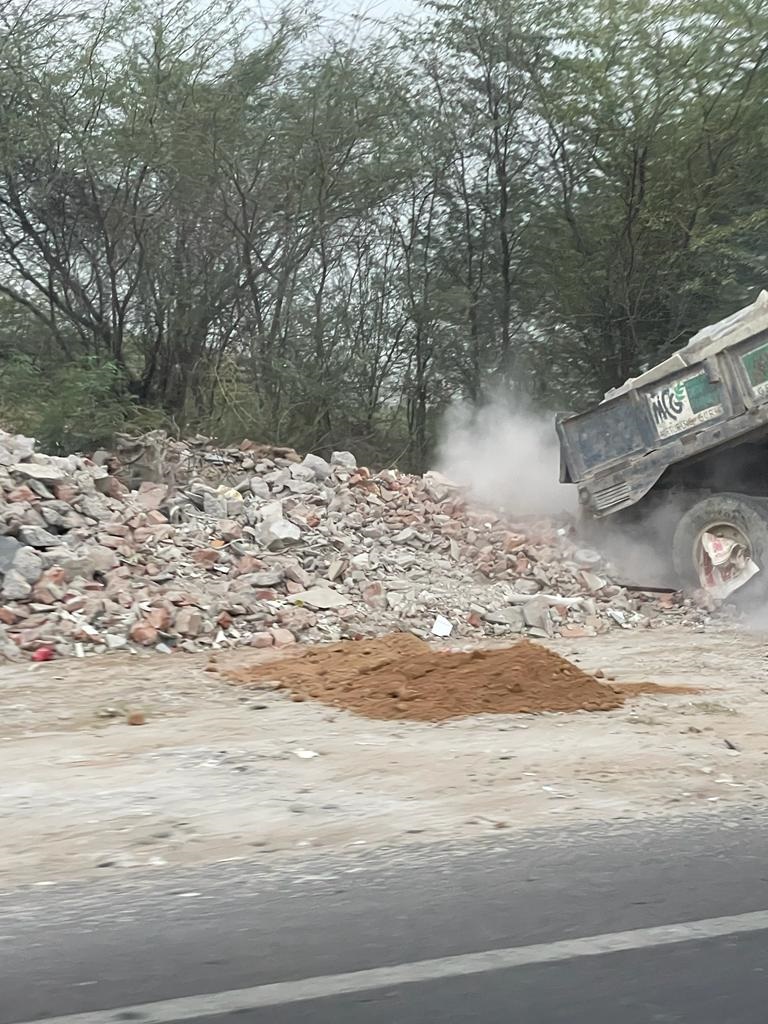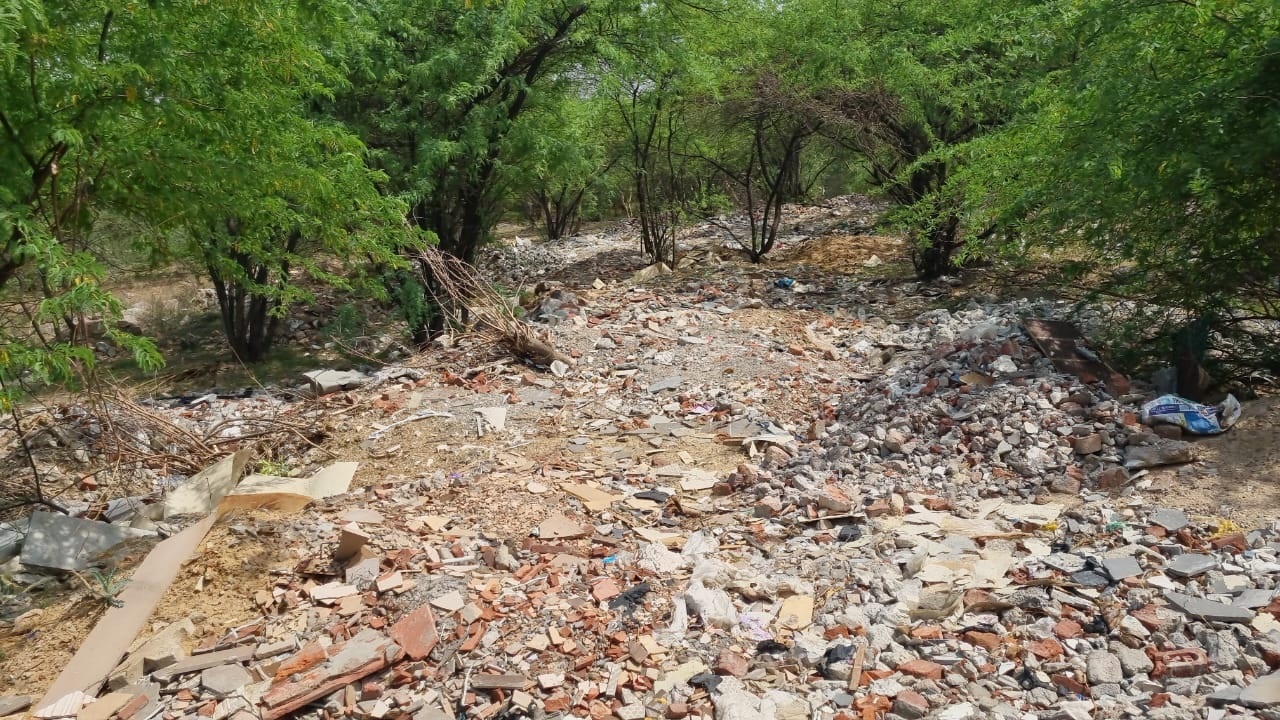
Thanks to rampant construction activities in Gurugram and Faridabad and lack of any plans to deal with the waste, the forests are witnessing a dumping of around 2000 tonnes of C and D waste on daily basis leaving them gasping for breadth,reports Aayush Goel
Having struggled with illegal mining, diminishing tree cover and official apathy for decades, Aravalis in South Haryana has the final nail in its coffin: Illegal dumping of construction and demolition waste.
The ‘forest’ covering 30,000 hectares of South Haryana spread across five districts of Gurugram, Faridabad, Mewat, Mahendargarh, and Rewari is fast turning from an endangered green lung or water recharge zone to acres of debris covered dump yard. All thanks to rampant construction activities in ever evolving Gurugram and Faridabad and lack of any plans to deal with the waste, forest is losing its last bit shred by shred. According to authorities, around 7000 construction projects are currently on in Gurugram and Faridabad with former accounting for almost 5000. These include not just mammoth societies or government infrastructure upgradation like flyovers, roads etc but also demolition and reconstruction of properties across the city. Gurugram, like any urban disaster, is going ahead commercialising and concretising and not caring about the dealing with by product which is dumped rampantly across roads, empty plots, green belts and then ultimately in Aravalis. The forests, according to environmentalists, are witnessing a dumping of around 2000 tonnes of C and D waste on daily basis which is pushing it towards its ultimate death. “The forest has been converted into dumpyard. Day and night, trolleys carrying tonnes of non-biodegradable debris come and dump here. The debris is concretising the forest, degrading the sand quality and killing existing flora and fauna and aquifers. When there are forces trying to save the dying forest, this unchecked dumping is defeating the purpose,” said Jatinder Bhadana of Save Aravali Trust.
Gurugram biggest culprit
The city has been under-construction since what seems an eternity now. Ask any resident, construction activities are apparently a never-ending phenomenon. Be it highways or infrastructure upgrade or foot over bridges, development of new residential sectors or housing projects or rampant illegal constructions in every single lane and street, it has become an inevitable part of their lives.
The city has, as per Municipal Corporation survey, been producing 2500 tonnes of debris each day. While as per norms it is the responsibility of the builder to arrange for its disposal and treatment but lack of enforcement has given way to one of the biggest mafia in NCR (National Capital Region) : The dumping mafia being run by local contractors, goons and even councillors. These tractor, trolley and arms equipped men go around city collecting debris at whooping 5,000 to 7,000 rupees a trolley and dump it in Aravali. While local residents of forest try to protest but they can’t do much. Things had taken a hopeful turn during Lockdown in 2020 when a Haryana IAS officer Vinay Pratap Singh spearheaded the move to clear the waste. The authorities with help of its contractor Pragati Natural Resources Private Limited went on to clear around one lakh twenty five thousand tonnes of construction and demolition waste in last seven months making it highest annual clearing ever in NCR . The amount stood at meagre 4643 tonnes in 2019. The move won authority laurels and it even made to NITI Aayog’s report asking other cities to follow the suit but this was short lived as the authorities grew lackasidical in 2021 and ever since Aravalis is going down the drain.

Storm water drains and Ground Water Recharge zones blocked Indigenous Flora lost.
Gurugram and Faridabad have been subjected to flash floods every monsoon since last 6 years. The reason behind same is cited as lack of any rain or storm water drains. The debris dumped in forest has clogged these drains leaving to biggest civic fiascos. It has also almost covered the ground water recharge zones leading to ever depleting water tables in Gurugram, Faridabad and Mewat. The civic agencies while clear intercity drains, hardly any attention is spared for clearing these foothill drains and entire city is drowned in just an hour of rain. Over 80 identified storm water drains and 30 recharge zones have been covered by debris in Aravalis so far. The forest is also witnessing loss of its indigenous flora comprising Dhau (Anogeissus pendula), dhak (Butea monosperma) and salai (Boswellia serrata), kadam (Mitragyna parvifolia), bistendu (Diospyros cordifolia) and basa (Albizia odoratissima), which cannot fight this concretisation.
Forest Inhabitants left to Suffer
“We have been fighting for decades to keep this forest our home intact. Currently Mangar Bani is only intact patch of forest but don’t know for how long we can hold up. You can fight against builder, those come to cut trees and governments but how do you fight against faceless mafia that just comes and dumps?,” says Sunil Harsana of Mangar Bani. This is not a lone case as residents of villages like Sakatpur, Gairatpur Bass, Naurangpur, Bargujjar, Tikri, Gahmroj, Aklimpur, Bhondsi, Alipur, Hariyaheda and Shikhohpur, Kota, Khandewala, Gangani, Mohammadpur Ahir, Kharak, Jalalpur, Chehlka and Bhango are facing the same plight. The state government in its pompous declaration has announced an Aravali safari park on 10,000 acres but residents are doubtful.
“What will you show people these mounds of debris? The trees, berries and fodder are dying. We are traditionally a cattle-bearing community and now we cannot do so because our self-sufficient forest is a dump yard,” says Suchet Dhar, a Kota resident.
Lack of Enforcement: Aravalli task force a distant dream
Despite being demanded for years, an Aravalli task force is yet to be set up. The state government had in 2018 approved a detailed plan to set up a task force that would have curtailed the mafia along with ills of poaching but it is yet to materialise. A senior environmentalist Vaishali Rana Chandra has been fighting for the cause for decades. “They need to have an Aravali Task Force…a team comprising of forest guards, MCG officials and some volunteers from the city working for the cause. There should be patrolling of Aravalis on Gurgaon-Faridabad road to check C&D waste dumping as well as municipal waste dumping (mixed municipal waste plant a havoc at Bandhwari forest area). I have been recommending this to the authorities for almost 4-5 years now. But the authorities just don’t care as long as the bureaucrats keep getting their salaries, they while away their time here till they are transferred out!!! And the CM is equally clueless who has made multiple visits to Bandhwari, Aravallis and seen the situation on ground but has taken no action,” she says.
The forest authorities say that it’s high time that civic agencies take up enforcement dealing with the debris at source.
“We do not have enough staff to go chasing the dumping mafia now. The civic authorities lack enforcement which encourages illegal dumping. They should get contractors or their officers to check illegal dumping in Aravalis,” said a senior official of forest department Gurugram
Haryana Forest Cover
Haryana is amongst states with poorest forest cover. The current forest cover in the state is 1,603.48 square km, which is 3.63% of the state’s geographical area. The forest cover of the state was recorded as 1,602.44 in 2019, 1,588 square kms in 2017 and 1,580 square km in the 2015 reports. Among districts, Gurugram has lost nearly 2.5 sq km of forest cover — the highest in the state. There were nine other districts – Faridabad, Bhiwani, Hisar, Jhajjar, Karnal, Mewat, Palwal, Rohtak and Yamunanagar. While Gurugram lost 2.47 sq km of forest cover during the four-month study period, Bhiwani saw a loss of 2.39 sq km, Nuh 0.55 sq km, Rohtak 0.74 sq km, Faridabad 0.71 sq km, Karnal 0.60 sq km and so on. Gurugram’s total forest area now stands at 113.71 sq km. The state leads the country in maximum diversion of land for non-forest activities.
Forgotten solution: Construction and Solid waste treatment Mobile Units
Gurugram had long found the solution but never cared to utilise it properly. An ambitious plan was once made to recycle its construction waste in tiles and use it to beautify and support public constructions. As per the initial plan a mobile C&D waste recycling plant was to be operationalise in the city. The units which would have moved around using a tractor would have changed the current approach to waste treatment to a more proactive one. The units would approach construction sites and treat the non-contaminated concrete or masonry waste on spot. There was a plan to set up a semi-mobile and stationary C&D waste recycling unit that would have been responsible for removal of contaminants using magnetic separation for removal of ferrous material. The waste then be converted into grout, filler and tiles that would be used to make roads in city benches in parks etc.












